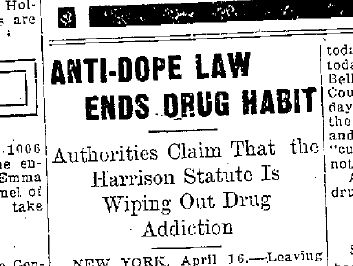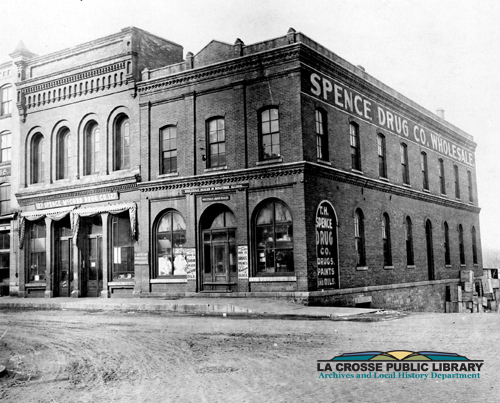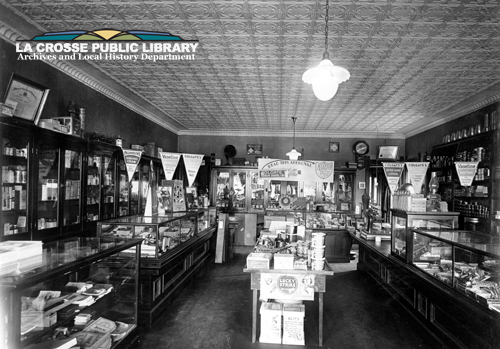
La Crosse's Drug Problem
(written by Barry McKnight, Archives staff)

La Crosse Tribune, 16 April 1915
Break-ins and robberies to support drug habits. Parents chasing after their addicted children trying to get them help. Addicts begging doctors and pharmacists for prescriptions. This is La Crosse’s drug problem … 100 years ago.
Opiates and cocaine had, during the 1800s, little in the way of regulation. Many widely used patent medicines contained doses of the drugs and were available in general stores, pharmacies or even from Sears & Roebuck. Opiates, sometimes in the form of tinctures mixed with alcohol, were often prescribed for “female troubles” and some women became addicted as a result. Opium dens, where the drug was smoked, existed in many metropolitan areas, including St. Paul and Minneapolis. By the end of the 19th century, however, injection was becoming more and more common as a way to abuse both cocaine and opiates.
In the eyes of the general public, drug abuse, began to be associated with criminal activity. An article from the May 23, 1906, issue of the La Crosse Tribune detailed an addict convicted of stealing silk handkerchiefs from the Park Store, what would later become Doerflinger’s department store. After being arrested, he suffered withdrawal so terribly in jail that he was finally given small doses of heroin to “quiet his nerves.” The article went on to detail how he would be weaned off the drug while serving his sentence at Waupun State Penitentiary. Another article from the Dec. 4, 1908, La Crosse Tribune recounted how a local woman, arrested in Waterloo, Iowa, for theft, fainted after being denied morphine while in custody. In July of 1913, a gambler and “opium fiend” arrested in La Crosse was released early after the county physician stated that it would be “torture” to continue to incarcerate him while he suffered from withdrawal.
Editorials locally and nationwide asserted that drug addiction, legal or not, encouraged crime. Many of the calls for tighter regulation contained racist elements. Cocaine and opiates were linked in newspaper editorials to African Americans and Chinese and fears of sexual violence. By 1914, the majority of states had enacted laws and regulations against cocaine and opiates such as heroin and morphine.
La Crosse Tribune, 4 February 1915
The Harrison Narcotics Tax Act was signed into law Dec. 17, 1914. The Harrison Act brought the distribution and production of cocaine and opiates under federal control. After it took effect on March 1, 1915, those drugs were only available with a prescription and doctors were under strict guidelines to account for every prescription. Because of this, doctors were unable to prescribe opiates to treat or ease addiction. It was proudly proclaimed that passage of the act would quickly eradicate the problem of drug addiction in the United States. Instead, it created an upsurge in crime as desperate addicts resorted to the black market to obtain the drugs and enterprising criminals acted to meet the demand.

La Crosse Tribune, 9 September 1915
In the months after the Harrison Act went into effect on March 1, 1915, La Crosse saw an upsurge in drug-related crime. In September 1915, the Spence-McCord Drug Co., located at Front and State Street, was robbed of its entire supply of heroin and morphine. The culprits were believed to be a professional gang of thieves who had been robbing drug establishments across the Midwest for months. The thieves entered the building by cutting the glass of a rear door and broke open the locked medicine cabinet with a chisel, all between rounds by the night watchman. It was believed that the thieves left La Crosse by train during the night.

Spence-McCord Drug Co., 127-129 N. Front St., undated

Spence-McCord Drug Co., 127-129 N. Front St., 1920s
In October 1915, two men stole a bottle of heroin from the Euler Pharmacy, located at State Street and West Avenue, after distracting the owner. The theft was quickly discovered and the two were caught a short time later after attempting to discard the evidence. Both were jailed and pled guilty to larceny, though not before being allowed an injection of morphine to quiet their nerves before appearing in court.
La Crosse Tribune, 2 October 1915
Robberies of pharmacies and medical offices continued beyond 1915. On July 4, 1916, Beyschlag’s Drug store at 503 Main St. was robbed of its entire supply of cocaine, morphine and heroin. Thieves entered the store by cutting the glass of one of the rear windows. One night in December of that year, two doctors offices located near Fifth and Main Streets were robbed of their entire supplies of morphine, cocaine, heroin and apomorphine (a drug used as an unofficial treatment for heroin addiction). Both robberies were again believed to be the work of a gang of professional drug traffickers operating in Wisconsin and Minnesota.
Some addicts were arrested not for committing theft but for suffering the effects of their addiction. In the days after the Harrison Act went into effect, a man was arrested after visiting the District Attorney’s office demanding protection from mysterious parties who were seeking to steal his tattoos. It was quickly determined that he was suffering withdrawal. In November of that year, the La Crosse Tribune reported that a man was arrested at a doctor’s office after being refused morphine. According to witnesses, he had pleaded for enough of the drug to last him until he got home to Rock Island and became agitated when refused. When arrested, he was in possession of a hypodermic and several morphine tablets.
Parents and family members also worried over what could be done about their addicted kin. Churches and the YMCA hosted former addicts who offered cautionary stories. Even traveling plays and motion pictures highlighted the dangers of drug addiction. The La Crosse Tribune ran a series of articles in January of 1917 detailing the plight of a couple from Eyota, Minn, who were searching the La Crosse area for their addicted daughter in an ultimately failed attempt to keep her from marrying the man who allegedly got her addicted.
La Crosse Tribune, 10 January 1917
Surprisingly little was done to help addicts break their addiction. Pejoratives like “drug fiend” were commonly used in newspaper articles. Few viewed addiction as a disease, and those that did were often misguided in their approach. Published in the La Crosse Tribune on March 1, 1915, the day the Harrison Act took effect, was an official looking advertisement from the Keeley Institute, an internationally known chain of clinics famous for treating alcoholism. The “Keeley Cure” for alcoholism consisted of rest at a clinic spa and injections of bichloride of gold, sometimes mixed with unnamed ingredients. Heavily criticized by the medical establishment, the Keeley Institute offered the chance of relief from addiction for those who could afford it.
La Crosse Tribune advertisement, 1 March 1915
The repercussions of the Harrison Act rippled across the country and were definitely felt in La Crosse. Authorities claimed that the Harrison Act would end drug addiction entirely. Instead, it created the modern view of the addict as criminal, relying on the criminal justice system to treat them, and it led to the black market for drugs that plagues cities like La Crosse still today.

